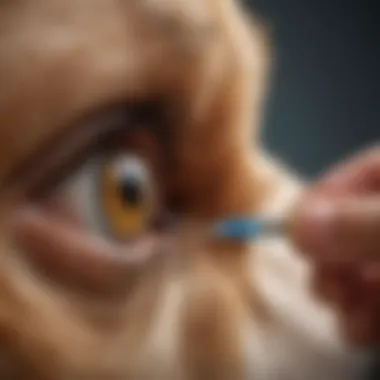Understanding Cyclosporine Eye Drops Side Effects in Dogs


Intro
The use of cyclosporine eye drops for dogs has gained prominence in veterinary medicine, primarily as a treatment for keratoconjunctivitis sicca, also known as dry eye. Understanding the side effects associated with this medication is crucial for both pet owners and veterinarians alike. Recognizing the signs of potential adverse reactions can facilitate timely interventions and adjustment of treatment plans. This overview will lay the groundwork for understanding these side effects by examining recent research findings, historical context, and current trends in its usage.
Research Overview
Veterinary studies have aimed to explore the broader implications of using cyclosporine in canine eye treatment. Most notably, findings from these studies provide valuable insight into the medication's effectiveness as well as its risks.
Key Findings
- Common Side Effects: Research indicates that the most frequently reported side effects of cyclosporine eye drops include conjunctival hyperemia, development of secondary infections, and transient stinging sensations post-application.
- Systemic Effects: Though rare, systemic absorption due to topical application has been observed. This can lead to nephrotoxicity or liver dysfunction in susceptible dogs.
- Long-term Use Impacts: Prolonged usage may decrease the drug's effectiveness over time, leading to increased dosing or alternative therapies.
- Variable Responses: There is variability in response among different breeds and ages, which is an important consideration when prescribing this medication.
Study Methodology
The studies conducted have involved both controlled clinical trials and real-world observations. Typically, the methodology includes:
- A diverse dog population to assess breed-specific reactions.
- Longitudinal monitoring of eye conditions pre- and post-treatment.
- Documentation of any side effects observed during routine veterinary check-ups.
Researchers often utilize pre-established grading systems for side effects to ensure consistent reporting among veterinarians. The data gleaned from these studies has been critical in shaping treatment protocols and providing guidance for future research.
Background and Context
Historical Background
Cyclosporine's introduction to veterinary ophthalmology marked a significant advancement in the management of ocular diseases. Initially formulated for transplant rejection in humans, its immunosuppressive properties later proved beneficial for treating ocular inflammation in dogs, which has gradually shifted the landscape of veterinary eye care.
Current Trends in the Field
The veterinary field has seen a greater focus on individualized treatment plans as understanding of cyclosporine’s pharmacodynamics grows. Pet owners increasingly expect transparency regarding possible risks linked to eye medications. This trend emphasizes the need for ongoing education for both owners and veterinary professionals concerning the side effects of medications like cyclosporine.
"An informed pet owner can significantly enhance the management of their dog’s ocular health by actively participating in treatment decisions and monitoring outcomes."
Next, we will delve deeper into individual side effects associated with cyclosporine eye drops, providing pet owners with detailed descriptions and possible interventions.
Prelims to Cyclosporine Eye Drops
Cyclosporine eye drops play a crucial role in managing various ocular conditions in dogs. They have become a common choice among veterinarians for treating issues like keratoconjunctivitis sicca, which can lead to serious complications if not addressed in a timely manner. This section discusses the significance of cyclosporine eye drops in canine ophthalmology, focusing on their benefits and necessary considerations that pet owners must keep in mind.
Understanding Cyclosporine
Cyclosporine is an immunosuppressive agent that helps in managing inflammation. In the context of eye drops, its primary function is to increase tear production. Dogs suffering from dry eye often experience discomfort and inflammation, leading to potential long-term damage if untreated. Cyclosporine works by targeting specific cells in the immune system, thereby reducing this inflammation while promoting natural tear flow. This mechanism is vital in restoring comfort and function to the eyes of affected dogs. Although beneficial, pet owners should be aware of its potential side effects and how they might impact their dog's health.
Application in Veterinary Medicine
In veterinary medicine, cyclosporine eye drops are frequently employed as a part of treatment protocols for dry eye conditions and other related disorders. The eye drops can be used alongside other treatments to enhance therapeutic outcomes. They are available as Optimmune, which is widely recognized in the field. The application of cyclosporine not only helps improve tear production but also alleviates discomfort associated with inflammatory eye conditions. Veterinary practitioners often assess the severity of a dog’s condition before recommending this medication, ensuring that it aligns well with the pet's overall health plan. It is essential for veterinarians to monitor the pets closely, looking for potential side effects and effectiveness of this treatment, to deliver the best possible care.
Mechanism of Action
Understanding the mechanism of action of cyclosporine eye drops is crucial in discerning how this medication operates at the biological level. This knowledge not only enhances comprehension of the drug's benefits but also allows both veterinary professionals and pet owners to make informed decisions regarding its use in treating canine eye conditions. In essence, the mechanism of action lays the groundwork for appreciating both the therapeutic effects and potential side effects associated with cyclosporine.
How Cyclosporine Works
Cyclosporine is an immunosuppressive agent primarily known for its role in transplant medicine, but it has established its significance in veterinary applications, particularly in ophthalmology. When applied as eye drops, cyclosporine inhibits the activity of T-lymphocytes, which are a type of white blood cell involved in the immune response. This inhibition is essential because an overactive immune response can lead to conditions such as dry eye, also known as keratoconjunctivitis sicca.


By reducing the activity of these immune cells, cyclosporine effectively reduces inflammation in the tissues of the eye. This action increases the production of natural tears, helping to mitigate the symptoms associated with various ocular diseases. Thus, understanding how cyclosporine works aids in recognizing its specific applications and effectiveness in treating eye conditions in dogs.
Effect on Canine Tear Production
One of the primary benefits of cyclosporine is its positive effect on tear production in dogs. It is not uncommon for pets, particularly older dogs or certain breeds, to experience reduced tear production, leading to discomfort, irritation, and even permanent damage to the eye if left untreated.
Cyclosporine acts to stimulate the lacrimal glands, which are responsible for tear secretion. The increase in tear production not only alleviates the symptoms of dryness but also helps maintain the overall health of the corneal surface. In clinical practice, it has been observed that most dogs treated with cyclosporine eye drops show an improvement in tear production, significantly enhancing their quality of life.
The significance of tear production extends beyond basic comfort levels, as adequate lubrication protects the eyes from injury and infection, which are common issues in dogs suffering from dry eye conditions. Ultimately, enhancing tear production through the use of cyclosporine eye drops plays a central role in comprehensive ocular health management in canines.
Cyclosporine eye drops not only alleviate symptoms but also restore essential functions in the eye, contributing to prolonged ocular health.
By examining these mechanisms, it becomes evident that a deeper understanding of cyclosporine's operation is vital in appreciating its role in veterinary medicine.
Commonly Treated Conditions
Understanding the commonly treated conditions with cyclosporine eye drops is crucial for both veterinarians and pet owners. Cyclosporine, a powerful immunosuppressant, allows for better management of various ocular disorders in dogs. The effective treatment of these conditions can lead to significant improvements in the quality of life for affected animals. Knowing these conditions helps pet owners understand when to seek veterinary care and aids veterinarians in diagnosing and recommending appropriate treatments.
Keratoconjunctivitis Sicca
Keratoconjunctivitis sicca, also know as dry eye, is one of the primary conditions treated with cyclosporine eye drops. This condition occurs when the tear glands do not produce enough tears. In dogs, this can result in discomfort, inflammation, and potential damage to the cornea.
Cyclosporine eye drops stimulate tear production, reducing the symptoms associated with dry eye. The drug helps restore moisture to the eye's surface, providing relief from irritation and preventing further complications. Pet owners should be observant for signs such as redness, squinting, or excessive blinking, indicating that their dog may be suffering from this condition.
Other Ocular Conditions
Besides keratoconjunctivitis sicca, cyclosporine eye drops are utilized for a range of other ocular issues. These include immune-mediated disorders, such as lymphocytic-plasmacytic conjunctivitis and certain cases of uveitis. These conditions can involve inflammation and require potent medications to control symptoms and prevent progression.
Cyclosporine's immunosuppressive properties make it an effective option for treating these disorders. It provides a comprehensive approach by helping to manage inflammation while supporting the overall health of the eye. As with any medical treatment, a thorough examination and appropriate diagnosis from a veterinarian are necessary to establish the best course of action.
Potential Side Effects
Understanding the potential side effects of cyclosporine eye drops in dogs is essential for both pet owners and veterinarians. These side effects may vary from mild to severe and can impact the pet's overall well-being. Recognizing these effects allows for better management and timely responses when adverse reactions occur. Awareness of side effects not only enhances the owner’s ability to observe and assess their dog but also aids in maintaining optimal eye health. It is crucial to weigh the benefits of treatment against these possible risks.
Local Side Effects
Local side effects occur directly at the application site. These can significantly affect the dog's comfort and adherence to the treatment regimen.
Irritation and Discomfort
Irritation and discomfort are common responses when using cyclosporine eye drops. This side effect manifests as redness of the eyes or rubbing at them. It often contributes to anxiety and reluctance to cooperate during dosing. Understanding this aspect is important as it sheds light on how sensitive the ocular area can be to foreign substances.
The particularity of this irritation is rooted in the sensitivity of a dog's eyes. This is a vital characteristic, as mild irritation might be an acceptable trade-off when weighed against the potential for improved eye health. Observing this response is a crucial part of managing the treatment.
Discharge from the Eyes
Discharge from the eyes can present as a watery or mucous-like fluid. This side effect can signify the eyes' attempt to cleanse themselves as a reaction to the foreign substance of the medication. This is relevant because an excessive amount of discharge could indicate a problem that warrants veterinary attention.
The key characteristic here is the color and consistency of the discharge. Clear discharge may not be alarming, but yellow or greenish discharge typically suggests infection. Recognizing the unique nature of the discharge is essential for prompt veterinary consultation.
Increased Lacrimation
Increased lacrimation is another local side effect that should not be overlooked. Often this results from enhanced tear production stimulated by the medication. While increased tears are generally a sign of healthy functioning tear glands, excessive lacrimation might disrupt the dog's daily activities and comfort levels.


The distinguishable feature of increased lacrimation is its proportionality. If the tears are excessive, it may warrant further evaluation. By understanding the signs, pet owners can take necessary actions to help their pets.
Systemic Reactions
Systemic reactions can happen when the medication impacts the body beyond the eyes. These reactions are crucial to note as they may signify more serious complications.
Gastrointestinal Upset
Gastrointestinal upset, including symptoms such as vomiting or diarrhea, can occur during cyclosporine treatment. Pet owners need to be vigilant as they can affect a dog's nutritional intake and hydration status.
The key aspect of this issue is its potential to compromise a dog's health through dehydration. Recognizing early signs allows for more effective management of the dog's overall condition while on cyclosporine.
Changes in Behavior
Changes in behavior can be subtle but significant. Dogs may exhibit restlessness or increased sensitivity to touch. This characteristic is beneficial to note since behavior changes can provide early indications of a side effect.
Pet owners must keep an eye out for these shifts. Understanding this side effect contributes to comprehensive care, ensuring that any adjustments in behavior are appropriately addressed.
Hypersensitivity Reactions
Hypersensitivity reactions can occur but are relatively rare. These may manifest as hives or swelling. It is critical to differentiate these reactions from more common ones to ensure the safety of the pet.
The notable aspect of hypersensitivity is its potential severity. If an owner detects any signs, immediate veterinary attention is necessary. Recognizing this side effect is crucial, as it can be life-threatening without prompt action.
Understanding Drug Interactions
Understanding drug interactions is crucial for optimizing the treatment of canine eye diseases, particularly when using cyclosporine eye drops. Many pet owners may not realize that various medications can influence each other’s effectiveness. This understanding is vital for ensuring the safety and efficacy of cyclosporine. If a veterinarian prescribes cyclosporine, knowing how it interacts with other drugs can prevent complications and adverse reactions.
Every medication has the potential to interact with others. With cyclosporine, the focus is on its role as an immunosuppressant. This property means it can alter how other medications work in the body. For instance, certain antibiotics or anti-fungal treatments may have their effects enhanced or reduced when given alongside cyclosporine, which can impact treatment outcomes.
Interactions with Other Medications
Cyclosporine can interact with a range of medications. These interactions might be pharmacodynamic, where two drugs affect each other’s mechanisms of action, or pharmacokinetic, where one drug affects the absorption, distribution, metabolism, or excretion of another. Here are some key considerations for pet owners and veterinarians:
- Antibiotics: Some antibiotics can increase the levels of cyclosporine in the bloodstream. This can lead to heightened effects and potential toxicity.
- Non-Steroidal Anti-Inflammatory Drugs (NSAIDs): Concurrent use of NSAIDs with cyclosporine can heighten the risk of renal issues, making monitoring of kidney function essential.
- Antifungal medications: Agents like ketoconazole can elevate cyclosporine levels, increasing side effects.
Monitoring interactions carefully is vital to prevent adverse reactions and ensure the best outcomes for the dog’s health.
It is important to keep an updated list of all medications the dog is currently taking. This comprehensive record aids veterinarians in assessing the risk of interactions prior to prescribing cyclosporine.
Importance of Veterinary Guidance
Veterinary guidance is paramount when it comes to administering cyclosporine or any other medication. Understanding the specifics of drug interactions not only allows for safer treatment protocols but also empowers pet owners to make informed decisions. Consulting with a veterinarian before any changes in a dog's medication regimen ensures that all aspects of the dog's health are considered.
Veterinarians have the expertise to analyze potential risks and benefits when cyclosporine is combined with other treatments. They are also well-equipped to manage any adverse effects that may arise. It is essential for pet owners to take an active role in communicating about their dog's medication history and any noticeable changes in behavior or health. Regular check-ups and open communication contribute significantly to effective management of eye health in dogs.
Monitoring and Management of Side Effects
When dogs receive cyclosporine eye drops, pet owners must be vigilant. Monitoring and managing side effects is essential to ensure the overall well-being of the canine. Recognizing adverse effects early can prevent further complications and enhance the treatment process.
Understanding the signs and symptoms of discomfort can guide pet owners and veterinarians in making informed decisions. Proper ongoing assessment can lead to adjustments in dosage or changes in medication, if necessary. This proactive approach can significantly improve the outcomes of treatment, allowing for optimal eye health in dogs.
Signs to Monitor


Behavioral Changes
Behavioral changes can indicate how a dog is reacting to cyclosporine eye drops. These changes may be subtle, such as increased irritability or withdrawal. Monitoring these behaviors provides insight into the pet's comfort level and the treatment's efficacy.
One key characteristic of behavior changes to watch for is changes in eating habits or activity levels. A dog that is usually active may become more lethargic or vice versa. Observing these signs allows pet owners to make timely adjustments and consult with a veterinarian if necessary.
The unique feature of behavioral monitoring is its ability to highlight covert discomfort. Such changes are often overlooked but can be critical in assessing a dog's reaction to the treatment. By keeping a close eye on these behaviors, pet owners can effectively collaborate with veterinarians for a much more personalized approach to care.
Physical Signs of Discomfort
Physical signs of discomfort, such as excessive squinting or pawing at the eyes, should not be ignored. These signs can be crucial indicators of a reaction to cyclosporine eye drops. A dog experiencing discomfort may exhibit behaviors like rubbing their eyes or keeping them closed more than usual.
Highlighted as a primary indicator of potential side effects, the presence of these physical signs is beneficial for timely intervention. Recognizing them allows for faster communication with veterinarians, ensuring that adjustments can be made if necessary.
In terms of unique features, these physical signs offer tangible evidence of the dog's discomfort, making them easier to identify than behavioral changes. However, it’s essential for pet owners to understand that a combination of behavioral and physical signs gives a more comprehensive picture of how the medication is affecting the dog.
When to Consult a Veterinarian
Pet owners should be aware of specific instances when it is crucial to consult a veterinarian. If any signs of distress are observed, such as severe discomfort or significant changes in behavior, a veterinary consultation is advised.
Moreover, if the eye condition does not show improvement after a specified period, it is also time to reach out for professional advice. Clear communication about what symptoms arise can aid veterinarians in providing appropriate adjustments to treatment plans. Keeping a record of any changes and reactions can support this process, helping assess the best course of action.
Comparative Analysis with Other Treatments
When considering treatment options for canine eye diseases, a comparative analysis between cyclosporine eye drops and other medications is crucial. This section will highlight the significance of understanding alternative therapies and how they measure up against cyclosporine in terms of efficacy and side effects. Knowing all the options aids veterinarians and pet owners in making informed decisions to optimize the health of dogs.
Alternative Medications
There are various alternative medications available for treating conditions like keratoconjunctivitis sicca in dogs. Some prominent alternatives include:
- Lifitegrast: This is another eye drop medication used to alleviate the symptoms of dry eye. It works differently from cyclosporine by targeting inflammation in the eyes directly.
- Artificial Tears: Various formulations exist, such as Optixcare and Systane, which provide temporary relief from dry eye symptoms. While they don’t modify the underlying condition, they aid in lubricating the cornea.
- Prednisolone Acetate: A corticosteroid drop used to reduce inflammation quickly, but prolonged use can pose risks of other side effects.
Each of these medications has its specific benefits, and the choice often depends on the dog’s particular condition and overall health status.
Efficacy vs. Side Effects
Considering efficacy versus side effects is vital in treatment selection. Cyclosporine may be effective in increasing tear production and managing inflammation in the eyes, but like any medication, it can produce adverse reactions, some more prominent than those associated with alternative options.
- Efficacy: Many studies demonstrate that cyclosporine significantly improves tear production. Its long-term use can yield superior results for managing chronic conditions compared to other treatments.
- Side Effects: Common side effects include localized irritation and hypersensitivity reactions. In contrast, alternatives may have a different side effect profile, with corticosteroids posing a risk of increased intraocular pressure.
Understanding these distinctions permits a more tailored approach to canine eye health. While cyclosporine may be the primary choice for chronic dry eye, mapping out the complete side effect landscape in comparison to alternatives provides a clearer picture for achieving optimal treatment outcomes.
Key Insight: Selecting the right medication requires careful consideration of both efficacy and safety, ensuring that the chosen therapy aligns with the dog's health needs and lifestyle.
In sum, a thorough comparative analysis of cyclosporine with alternative treatments is essential for veterinary practice, as preferences may vary based on individual circumstances. This knowledge empowers dog owners and veterinarians to engage in a dialogue that prioritizes the well-being of the canine patient.
Finale
Understanding the side effects of cyclosporine eye drops in dogs is vital for pet owners and veterinarians alike. As a commonly prescribed medication, it is essential not only to know its therapeutic benefits but also its potential adverse effects. This knowledge allows for informed choices in treating ocular conditions.
Summarizing the Use of Cyclosporine Eye Drops
Cyclosporine eye drops serve a significant role in managing eye conditions such as keratoconjunctivitis sicca. Their primary function is to enhance tear production and reduce inflammation. While many dogs respond positively, some may experience side effects ranging from local irritation to systemic reactions. Regular veterinary check-ups after initiation of treatment can aid in monitoring these effects.
Final Thoughts on Managing Eye Health in Dogs
Managing eye health in dogs requires a multifaceted approach. Beyond using cyclosporine, pet owners should be aware of other treatment options and the importance of ongoing assessment. Collaboration with a veterinarian ensures the best care decisions. It is crucial to address concerns promptly and adapt the treatment plan to optimize eye health effectively.
"Proactive management of eye conditions can lead to better outcomes and improved quality of life for dogs."







